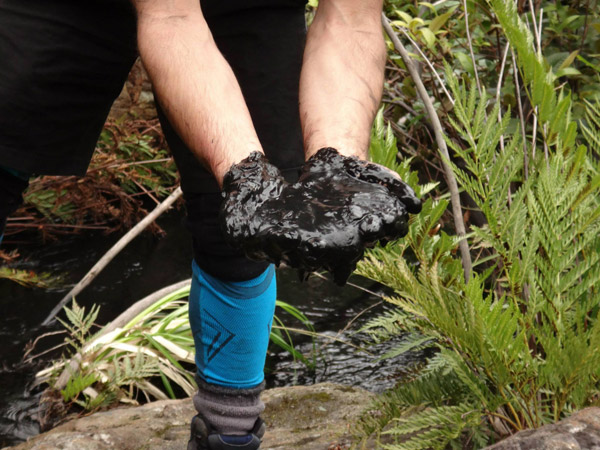AN ACCIDENT WAITING TO HAPPEN - 2015 Clarence mine waste collapse
Centennial Coal's day in court
The hearing for the prosecution of Centennial Coal for the massive coal fines waste collapse from its Clarence Colliery was finally held on 8 May at Sydney's Land and Environment Court. The society attended to learn how it happened and what the penalty will be.
To recap, in July 2015 a huge mine waste collapse from Clarence Colliery, near Lithgow, sent tonnes of toxic coal fines into a channel and then into the Wollangambe River.. There it turned into a black sticky sludge extending down the river and smothering its banks for 10 kms. It is likely to have caused significant damage to aquatic life in the river. Environmental groups, including the society, as well as walkers and canyoners raised concerns about the impacts on the river and our world heritage national park.

The EPA-directed clean-up of the river took nearly a year, at a cost of around two millions of dollars to the owners of Clarence Colliery. According to the Environment Protection Authority (EPA) " A total of 214 tonnes of coal fines have been removed by hand and the company has made more than 700 trips in a helicopter to airlift bulka bags of coal fines out of the Blue Mountains National Park."
Prosecution announced
Clarence Colliery (owned mainly by Centennial Coal) pleaded guilty to a Tier One pollution charge (the most serious level) under the Protection of the Environment Operations Act and to damage to a national park under the National Parks and Wildlife Act. In August 2016 the Society wrote to the EPA asking them to seek the maximum penalty and a sentence which would ensure such a damaging event by this company does not happen again.
"AN ACCIDENT WAITING TO HAPPEN" - Court hearing 8 May 2017
The incident
The prosecution and defendant (Clarence Colliery) agreed that Clarence had been pumping coal fines slurry into a hole in a containment area which collapsed when it was overfilled. The national park boundary was only 400 metres away.
The EPA's barrister said the spill was "an accident waiting to happen". The pumping of the coal slurry into the hole was handled in a very incompetent and casual manner. No records were kept of how much slurry had been pumped and how high it was. There were no flow meters. Deciding whether the hole was full was done by visual checking. At night, staff only had a headlight or car headlights to check on the height of the slurry. As well, Clarence had ignored expert geotechnical advice that the stability of the waste needed to be improved and their water management plan did not anticipate this slurry would even be sent to this hole.
The lack of records mean that we will never know how much coal fines went into the world heritage area. Even the records of what was taken out during the clean-up were guesstimates.
What will the penalty be?
The maximum penalty for the pollution charge is $2 million and for the national parks charge is $1.1 million. However, the judge has to take into account the seriousness of the event and the rules relating to sentencing. For instance, the penalty can be reduced by 25 per cent if the defendant pleads guilty soon after the charges are laid. Clarence Colliery did enter an early guilty plea.
Clarence Colliery stated that it had no prior convictions. Frustratingly, however, Clarence's main owner, Centennial Coal, has had several convictions for pollution incidents at its other mines. As well, in 2011 two Centennial coal mines entered into an enforceable undertaking of $1.45M with the Commonwealth government for mining without approval which damaged to three nationally listed Temperate Highland Peat Swamps.
Orders sought from the court
The EPA has sought an environmental service order so the penalty money can at least be spent on some environmental works or other physical community benefits in the general area of the offence. What that would be was still being finalised at the time of the hearing.
The EPA also sought a publication order. Typically, this is a statement published in newspapers, setting out what the offender did and the court's penalty.
The judge, Robson J, has reserved his decision on the penalty.
|

